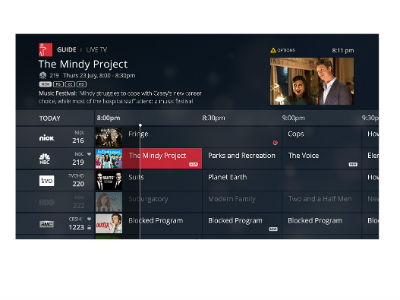INTX 2015: Espial ‘G4’ STB Client Targets RDK & More

Espial, a supplier of video software and user interface technologies, has launched G4, a fourth-gen set-top box client for cable operators, telcos, satellite TV and other types of video service providers that can weave together linear, on-demand and Internet-based content into a uniform interface.
G4, the Ottawa-based company said, can integrate third-party recommendation engines and run on most set-top box platforms, including devices outfitted with the Reference Design Kit (RDK), the preintegrated software stack for IP and QAM/IP hybrid set-tops and gateways that’s being managed by Comcast, Time Warner Cable and Liberty Global.
Three unnamed operators – one “major” MSO in North America and two in Western Europe -- have selected G4 for their next-gen video platform, Jeff Huppertz, Espial’s vice president of marketing and business development, said. All three operators in question have at least 1.5 million subs, and about 8 million between them, he said, noting that they are also discussing G4 implementations on the RDK.
Of Espial’s trio of MSO customers committed to G4, the one in North America is tapping the platform to power an new all-IP platform, while the two in Europe will use it for their respective hybrid QAM/IP networks.
Operators, Huppertz said, can use the HTML5-powered G4 platform to develop and roll out fluid, customized interfaces, and continue to add and tweak the look and capabilities of the interface.
“The operator owns the look and the experience…and making changes to [the UI] is as easy as changing Web pages,” Huppertz said, noting that pay TV operators have been stepping up their video interface development amid over-the-top competition and as programmers continue to enhance their own apps and launch or develop new stand-alone services.
But Espial has plenty of competition, including TiVo, which has had success with mid-sized tier 1s in the U.S. and some major ones in Europe, as well as from the operators themselves – Comcast and Charter Communications, for example, have developed next-gen video platforms largely through in-house projects. Time Warner Cable has also developed a cloud-based interface based on HTML5 that will run on the RDK.
The smarter way to stay on top of the multichannel video marketplace. Sign up below.
Huppertz said the addressable market for G4 includes operators of all sizes that are still developing next-gen video strategies. “We think it’s a wide-open opportunity,” he said.
While G4 is a set-top box-focused client, Espial’s also has solutions operators can tap into to bring similar experiences to multiscreen devices.
Founded in 1997, Espial posted 2014 revenues of $20 million, a year-on-year increase of 59%. Mike Hayashi, the long-time TWC engineering exec who announced his retirement last year, recently joined the Espial board of directors.
